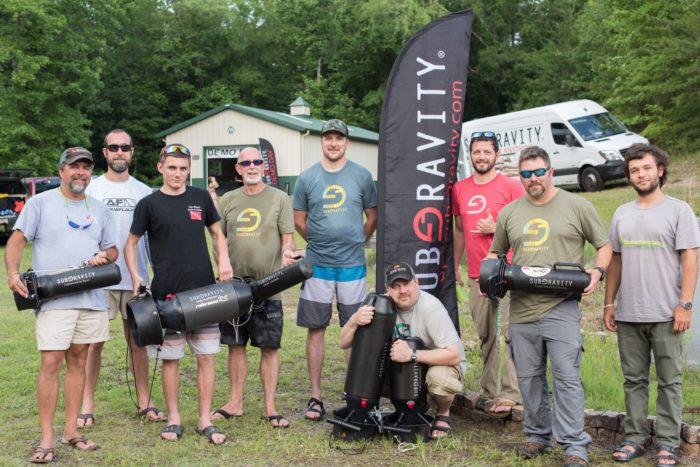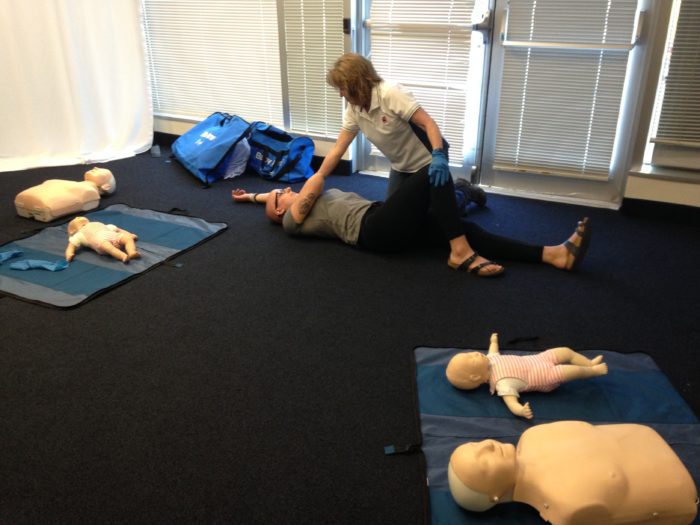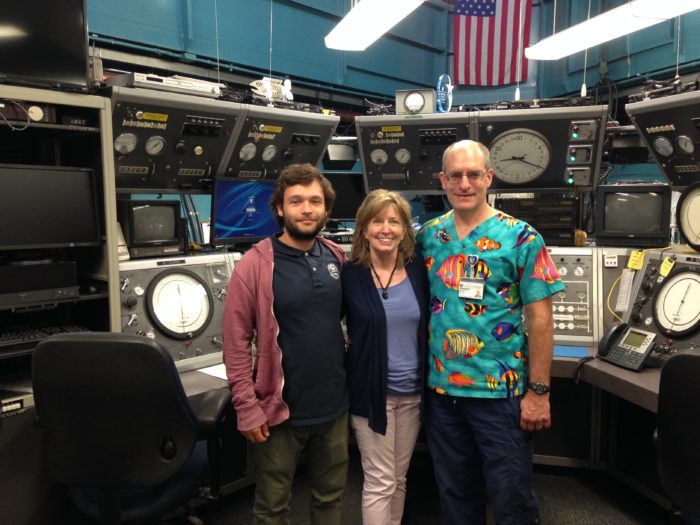Subgravity Skills Bootcamp
Divers Alert Network (DAN) was my next stop on this journey, but before getting there I paid a visit to last year’s North American Rolex Scholar Leah Potts and her Subgravity team! Subgravity specializes in providing the diving community with very technical gear for more specific diving, such as caves, wrecks, mixed-gas and rebreathers. The past couple of weeks they have been hosting day events and workshops to get divers to try out some gear. The cool thing about these events is that they not only offer a neat and safe space to try technical diving, but also aim to bring together local dive shops and endorse community building between them.


I spent the first day helping Leah sort out participants and carry things around the quarry dive sites. For those unfamiliar, a quarry is essentially a hole in the ground that has been flooded and interesting objects have been sunk into it to make it attractive for divers to swim around. Lucky for me, I got to try out diving side-mounts, rebreathers and scooters all in one day! It was a weekend packed with stretching my recreational scuba diving limits.
Side-mounts are typically used in caves as they allow you to place your tanks (that’s right, two or more!) on your sides to squeeze through gaps easier. This completely changes your balance and trim underwater as the weight distribution is totally different. We managed to test our skills squeezing through a sunken plane’s windows.
Rebreathers were definitely an experience as well. Rebreathers are a closed-circuit (CCR) system of diving, which basically means that you recycle the air you breathe and do not release bubbles. They use a carbon-scrubber and filter out carbon dioxide to clean the oxygen. There is a lot more that’s happening when you are on a rebreather, the system is complex, heavy and requires a lot of formal training to master. But it’s something I’m definitely thinking about picking up in the future for the benefits it has underwater, like being able to stay completely silent with no bubbles and lasting longer, way longer.
Scooters were by far the most fun! They are these compact (ish) turbines that you grab or strap on you to propel yourself through the water. It’s probably one of the closest things to flying. Now picture eight to ten divers with huge grins on their faces darting around a sunken school bus and buzzing around in circles. It’s just crazy to think of what humans have come up with to entertain themselves nowadays.
To add to the experience, Leah also took me through the basics of photogrammetry – a tool that I aspire to get acquainted with in the future. Photogrammetry lets you take pictures of objects and produce 3D models of them. This technique is becoming more and more popular in science, conservation and archaeology. Lucky for me I had a great model that was willing to get decapitated in order to get the job done!

The Medical Side of Diving
After a weekend full of fun and intense gear hauling I was dropped off at DAN where I met Patty Seery, who would adopt me for the upcoming week. Just a shoutout to Patty for being a truly inspiring and dedicated individual who does so much for her community and expects nothing in return. And to her dog Scuba for being an adorable little pup. My time at DAN included first aid training, learning about research, medical services, hotlines, marketing and communication – time definitely well spent.


Patty took me and three of DAN’s interns through a first aid course which will definitely make me a little more confident about being out in the field. Not only that but I had the opportunity to visit Duke University’s Hyperbaric Chamber. This facility is outstanding; it houses a set of tunnel-like containers that look like incubators, which can exert high pressure to treat decompression illnesses. There is ongoing research that is fascinating and their equipment is nothing like I’ve ever seen before. They contain wet and dry chambers where people spend days inside for treatment. The staff at the chamber was really kind to talk me through some of the processes and the way they use oxygen therapy to treat patients. Familiarizing myself with the technology and research regarding hyperbarics was eye-opening, but what impacted me the most was learning about the places where decompression is a disregarded outcome of the risks in making a living.

DAN has worked with several communities around the world, but I got to learn about some of the specific work they have done in Latin America, where diving has become the main tool for fisheries in certain communities. Unfortunately, these fishers don’t benefit from the resources that the greater diving world takes for granted, and I was impressed by the range of challenges that they all face when trying to keep safe – or the challenges they face when they can’t afford to be concerned at all.
Decompression illness is no joke. It may cause excruciating pain, paralysis or even death. And understanding that, as divers, we have the responsibility to advocate for safety and play a greater role in offering support to those that do not have the privilege to partake in diving as a safe recreational practice or work platform. And understanding that, as humans, the things we eat have an impact on someone else’s life should be enough to make a greater effort in opting for sounder consumer choices where we can.
I invite you to get informed on the work DAN does, and read a little bit about how they reach out to communities. To my knowledge, there really is no one else that does this.
A Carolina del Norte – Introducción al buceo técnico y a la medicina del buceo
Taller de introducción técnico Subgravity
Divers Alert Network (DAN) fue mi siguiente parada en esta aventura, aunque antes visité a nuestra becaria de Norteamérica Rolex del año pasado,Leah Potts y su equipo de Subgravity.
Subgravity se especializa en proveer de equipo técnico a la comunidad de buceo, para buceo específico como cuevas, barcos hundidos, mezcla de gases, y circuitos cerrados (o rebreathers). Durante las últimas dos semanas han estado ofreciendo eventos diarios y talleres para que los buzos prueben nuevos equipos. De esta manera, no sólo pueden probar el buceo técnico en un espacio limpio y seguro, sino además ayudan a las tiendas locales de buceo a construir un sentido de comunidad entre ellas.


Pasé el primer día ayudando a Leah con los participantes y acarreando equipo entre canteras de buceo.
Una cantera es básicamente un hoyo en la tierra que ha sido inundado, y se le han echado objetos interesantes, que al hundirse crean una atmósfera atractiva para bucear. Por suerte para mí, me tocó probar sidemounts, rebreathers y scooters, ¡todo en un sólo día! Fue un fin de semana lleno de buceo recreativo llevado al límite.
Los Side-mounts son una configuración de montaje lateral de tanques que se usan típicamente en cuevas, ya que te permiten poner tus tanques (dos o más) a tus costados, para poder meterte en espacios reducidos más fácilmente. Esto cambia completamente tu equilibrio y flotabilidad bajo el agua ya que la distribución del peso es totalmente diferente. Logramos probar nuestra destreza estrujándonos a través de las ventanas de un avión hundido.
Los Rebreathers , sistemas con circuitos cerrados de respiración, fueron toda una experiencia también. Estos sistemas permiten reciclar el aire que se respira y no liberar burbujas. Usan un purificador de carbón que depura el dióxido de carbono para limpiar el oxígeno. Estar en un “rebreather” es pesado, complejo y requiere de un entrenamiento formal para controlarlo. Definitivamente es algo que me gustaría continuar aprendiendo en un futuro por los beneficios que tiene bajo el agua, tales como permanecer en silencio absoluto, sin burbujas, por tiempos largos, mucho más largos.
¡Los Scooters, fueron sin duda los más divertidos! Son estas pequeñas turbinas de donde te sostienes o te amarras con correas para impulsarte a velocidad por el agua. Es probablemente lo más cercano a volar. Imagínate unos ocho o diez buzos con enormes sonrisas lanzándose y zumbando alrededor de un camión de escuela hundido. Es una locura lo que inventan los humanos para entretenerse actualmente.
Para mejorar la experiencia, Leah me guió en la fotogrametría básica, una herramienta con la que espero familiarizarme en el futuro. La fotogrametría te permite tomar fotos de objetos y modelarlos en tercera dimensión. Esta técnica se ha vuelto más y más popular en la ciencia, la conservación y la arqueología. Para mi fortuna tuve una modelo maravillosa, ¡que se dejó decapitar para poder hacer mi trabajo!

El lado médico del buceo
Después de pasar un fin de semana lleno de diversión y cargamento de equipo, me dieron aventón a DAN, donde conocí a Patty Seery, quien me adoptaría por la siguiente semana. Una porra a Patty por ser una persona verdaderamente inspiradora que le dedica muchísimo a su comunidad sin esperar nada a cambio. Y a su perro Scuba, por ser un adorable cachorro. Mi estancia en DAN incluyó aprendizaje sobre primeros auxilios e investigación, servicios médicos, líneas directas y comunicación – un tiempo definitivamente bien utilizado.


Patty nos dió a tres internos de DAN y a mí un curso de primeros auxilios que definitivamente me ayudó a tener más confianza para estar en el campo. No sólo eso, tuve la oportunidad de visitar la Cámara Hiperbárica de la Universidad de Duke. Estas instalaciones son excepcionales; albergan un grupo de contenedores en forma de túneles, como incubadoras, que pueden ejercer altas presiones para tratar enfermedades de descompresión. Se realizan investigaciones fascinantes con equipos que nunca había visto. Tienen cámaras húmedas y secas donde la gente pasa días adentro para tratamientos. El personal de la Cámara fue muy amable conmigo, explicándome procesos y medios donde usan terapias de oxígeno para tratar pacientes. El familiarizarme con la tecnología e investigación hiperbárica fue ilustrativo, pero lo que me impactó fue saber que hay lugares donde la descompresión es un evento ignorado de los riesgos para ganarse la vida.

DAN ha trabajado con varias comunidades alrededor del mundo, pero han hecho un trabajo específico en Latinoamérica, en donde el buceo se ha convertido en la herramienta principal para las pesquerías en ciertas comunidades. Desafortunadamente, estos pescadores no se benefician de los recursos que el mundo del buceo en su mayoría da por hecho. Y me impresionó la cantidad de retos que enfrentan al tratar de mantenerse a salvo- o los desafíos que enfrentan cuando no pueden darse el lujo de preocuparse en lo absoluto.
La enfermedad de descompresión no es ningún chiste. Puede causar dolor extremo, parálisis y hasta la muerte. Al entender esto, como buzos, tenemos la responsabilidad de abogar por la seguridad y brindar más apoyo a aquellos que no tienen el privilegio de participar en el buceo como una práctica recreativa segura o plataforma de trabajo.
Y entender que, como humanos, lo que comemos tiene un impacto sobre la vida de alguien más, debería ser suficiente para elegir mejor lo que consumimos cada vez que podamos.
Los invito a informarse sobre el trabajo que realiza DAN y a que lean un poco sobre cómo realmente se acercan a las comunidades. Que yo sepa, nadie más lo hace.